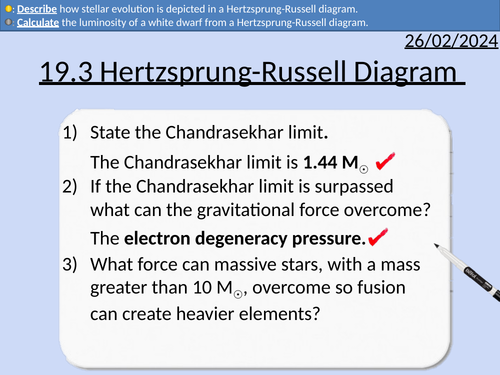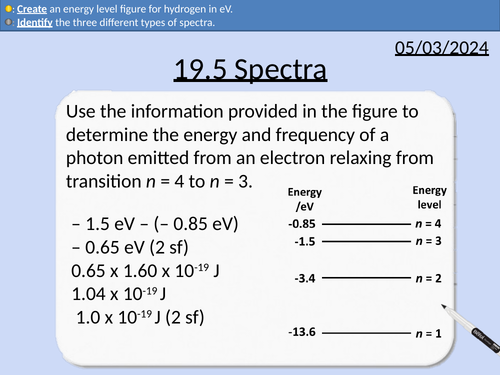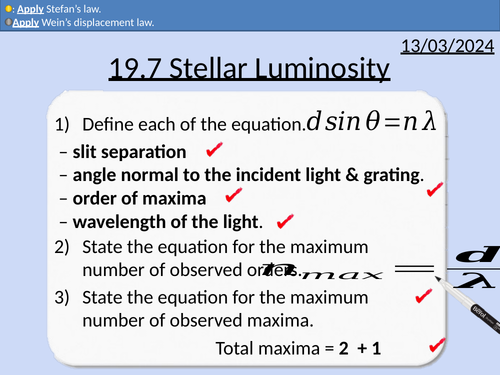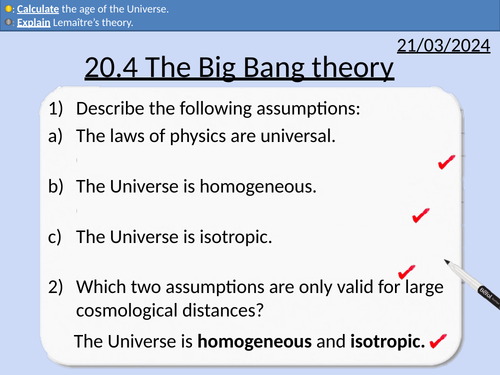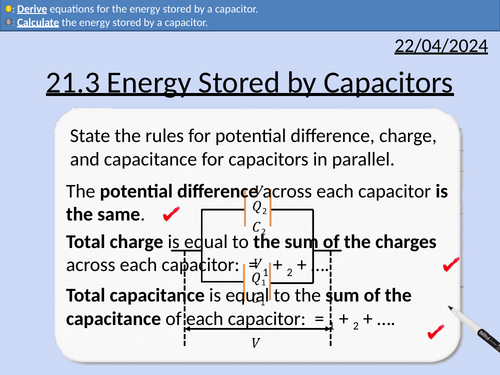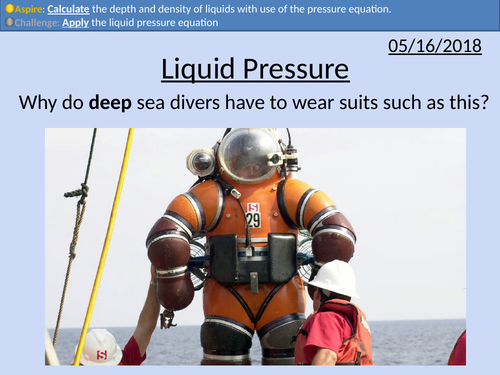497Uploads
169k+Views
72k+Downloads
All resources

OCR A level Physics: Life Cycles of Stars
OCR A level Physics: 19.2 Life Cycles of Stars
Module 5 Newtonian World and Astrophysics
This PowerPoint is a whole lesson included with student activities, animated answers, homework questions with answers provided.
This lesson covers:
Calculating mass in kg from solar mass
Life cycle of stars with a mass between 0.5 and 10 solar masses
Life cycle of stars with a mass above 10 solar masses
Pauli exclusion principle and electron degeneracy pressure
Red giants and white dwarfs
The Chandrasekhar limit
Red supergiants to black holes and neutron stars
Stellar nucleosynthesis

OCR A level Physics: Hertzsprung-Russell Diagram
OCR A level Physics: 19.3 Hertzsprung-Russell Diagram
Module 5 Newtonian World and Astrophysics
This PowerPoint is a whole lesson included with student activities, animated answers, homework questions with answers provided.
This lesson covers:
Definition of luminosity
Usual axis choice of a HR diagram.
Identifying the positions of the main sequence, white dwarfs, red giants, and red supergiants.
Description of how stellar evolution is shown in a Hertzsprung-Russell diagram.

OCR A level Physics: Spectra
OCR A level Physics: 19.5 Spectra
Module 5 Newtonian World and Astrophysics
This PowerPoint is a whole lesson included with student activities, animated answers, homework questions with answers provided.
This lesson covers:
The electromagnetic spectrum and wavelengths
Definition of spectroscopy
Electrons and energy levels
Continuous spectra
Emission spectra from gases
Absorption spectra from gases

OCR A level Physics: Stellar Luminosity
OCR A level Physics: 19.7 Stellar Luminosity
Module 5 Newtonian World and Astrophysics
This PowerPoint is a whole lesson included with student activities, animated answers, homework questions with answers provided.
This lesson covers:
The electromagnetic spectrum, frequency/wavelength, and temperature
Black body radiation
Wein’s displacements law
Stefan’s law (Stefan-Boltzmann law)

OCR A level Physics: The Big Bang Theory
OCR A level Physics: 20.4 The Big-bang
Module 5 Newtonian World and Astrophysics
This PowerPoint is a whole lesson included with student activities, animated answers, homework questions with answers provided.
This lesson covers:
Georges Lemaître’s Theory
Evidence for the Big Bang Model
Hubble’s Law (expanding Universe)
Microwave Background Radiation
Source of the Microwave Background Radiation
Hubble’s constant and the age of the Universe

OCR A level Physics: Energy Stored by Capacitors
OCR A level Physics: 21.3 Energy Stored by Capacitors
Module 6 Particles and Medical Physics
This PowerPoint is a whole lesson included with student activities, animated answers, homework questions with answers provided.
This lesson covers:
Work done of a capacitor depends upon the initial potential difference and capacitance.
Work done is provided by the source of potential difference.
Deriving three equations for work done of a capacitor.

OCR A level Physics: Electric Potential and Energy
OCR A level Physics: 22.5 Electric Potential and Energy
Module 6 Particles and Medical Physics
This PowerPoint is a whole lesson included with student activities, animated answers, homework questions with answers provided.
This lesson covers:
Definition of electric potential energy
Definition of electric potential.
Definition of electric potential difference.
Using a force-distance graph to determine electric potential energy
Using electron-volts and joules in calculations
Capacitance of an isolated charged sphere

OCR A level Physics: Electromagnetic Induction
OCR A level Physics: 23.4 Electromagnetic Induction
Module 6 Particles and Medical Physics
This PowerPoint is a whole lesson included with student activities, animated answers, homework questions with answers provided.
This lesson covers:
Electromagnetic induction produces an induced e.m.f
Conditions to produce electromagnetic induction
How to increase electromagnetic induction
Magnetic flux density, magnetic flux, and magnetic flux linkage
Units of weber (Wb)

OCR A level Physics: The Nucleus
OCR A level Physics: 24.2 The Nucleus
Module 6 Particles and Medical Physics
This PowerPoint is a whole lesson included with student activities, animated answers, homework questions with answers provided.
This lesson covers:
Nucleons
Isotopes
Nuclear notation
Atomic mass units (u)
Radius for atomic nucleus equation
Volume and density of atomic nuclei
The strong nuclear force

OCR A level Physics: Radioactivity
OCR A level Physics: 25.1 Radioactivity
Module 6 Particles and Medical Physics
This PowerPoint is a whole lesson included with student activities, animated answers, homework questions with answers provided.
This lesson covers:
Types of ionising radiation (alpha, beta-plus/beta-minus, gamma)
Penetration power and ionising power
Detecting radiation with a Geiger (GM tube) counter
Background radiation and correct count rates
Electric and magnetic fields affect ionising radiation
Cloud chambers

OCR A level Physics: Antiparticles, Leptons, & Hadrons
OCR A level Physics: 24.3 Antiparticles, Leptons, & Hadrons
Module 6 Particles and Medical Physics
This PowerPoint is a whole lesson included with student activities, animated answers, homework questions with answers provided.
This lesson covers:
Antiparticles, their properties, and symbols
Particle and antiparticle annihilation
The four fundamental forces (strong nuclear, weak nuclear, electromagnetic, and gravitational forces) and their properties.
Definition and examples of hadrons and leptons.

OCR Applied Science: 6.1 Mechanical Properties of Materials
This PowerPoint presentation with worked examples and student activities covers:
Topic 6.1 of Module 1: Science Fundamentals of the OCR Applied Science Spec.
• Interpreting laboratory tests for stress-strain graphs and Young’s modulus
• Awareness that repeated loading cycles may cause failure by fatigue below the yield strength
• Use of diagrams to understand that the way molecules are arranged in polymers determines the properties: chain length, crosslinking, use of plasticizers and crystallinity.
• Use and rearranging of the density equation.
Bundle

GCSE OCR Biology: B1.2 What happens in cells?
All resources for B1.2 What happens in cells? GCSE OCR Biology Gateway 9-1. Triple and combined (Higher and Foundation) is covered in this material.
Each PowerPoint is a whole lessons included with student activities and animated answers.
DNA stands for deoxyribonucleic acid.
DNA is found in the nucleus of cells.
DNA is packaged into a thread-like structure called chromosomes.
Humans typically have 46 chromosomes shared from their parents.
Genes are sections of DNA that code for physical characteristics.
The structure of DNA.
DNA is comprised of monomers called nucleotides.
A nucleotide consists of a phosphate group, a sugar (deoxyribose), and an organic base.
There are four organic bases: Adenine, A. Thymine, T. Cytosine, C. Guanine, G.
Hydrogen bonds in DNA.
The role of proteins and AI
Proteins as polymers
Explaining transcription
mRNA and complementary bases
Explaining translation
Enzymes are made of protein.
Enzymes are biological catalysts.
Catalysts speed up the rate of reaction without being used up themselves.
Enzymes and the lock and key hypothesis.
Enzymes breaking down and bonding substrates.
Enzymes-catalysed reactions
Rate of reaction
Denaturing of enzymes and the active site
Optimum temperature and optimum pH for enzymes
Definition of concentration
Increasing concentration of enzymes and substrates
Saturation of substrates

OCR A Level Physics: Satellites
OCR A level Physics: 18.5 Satellites
Module 5 Newtonian World and Astrophysics
This PowerPoint is a whole lesson included with student activities, animated answers, homework questions with answers provided.
This lesson covers:
Key features of geostationary and low polar orbit satellites
Conditions for stable orbits for satellites
Applying Kepler’s laws to the orbits of satellites

GCSE Physics: Electrostatics
This presentation covers OCR Gateway Physics 9-1 P3.1.1 Electrostatics
Subatomic particles and electric charge
Transfer of electric charge
Attraction and repulsion from electric charge
Electric field lines
Interaction of electric field lines
Van der Graff generator

GCSE Physics: Graphs of Current and Potential Difference (I-V)
This presentation covers OCR Gateway Physics 9-1 P3.2.4 Graphs of potential difference (p.d.) and current.
Linear circuit element
Non-linear circuit element
Diodes and Light emitting diode (LED)
Current against potential difference graphs
How the gradient of a current against potential difference graph relates to resistance
Experimental set-up for determining circuit elements
How temperature affects resistance in lamps and metal conductors (wires)

GCSE Physics: Magnets and Magnetic Fields
This presentation covers OCR Gateway Physics 9-1 P4.1.1 Magnets and Magnetic Fields.
Rules for repulsion and attraction
Magnetic Field Line Rules
Magnetic field density and magnetic force
Modeling the Earth as a Bar Magnet
Permanent and Induced Magnets
Magnetic Domains

GCSE Physics: Current and Forces with Equation
This presentation covers OCR Gateway Physics 9-1 P4.2.1 b Current and Forces.
Units for Magnetic Field Strength
Converting from mT to T
Magnetic Force Equation
Rearranging Equations
Increasing the force on a current carrying conductor in an external magnetic field.
Student questions and worked answers

GCSE Physics: Vectors and Scalars
This presentation covers OCR Gateway Physics 9-1 P1.2.2.
Content covered:
Definition for vector and scalar
Vector addition in 1 D
Vector addition in 2 D
Scaled drawings and Pythagoras’ theorem
Worked examples and student problems with answers included

GCSE Physics: Liquid Pressure
This presentation covers OCR Gateway Physics 9-1 P1.3.4 Liquid Pressure
This presentation includes:
Liquid pressure equation
Worked solutions
Exam style questions with answers
Rearranging equations
Incompressibility of liquids.


